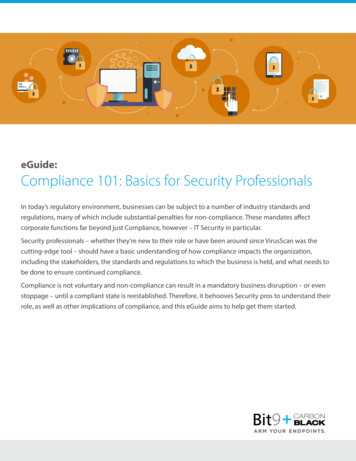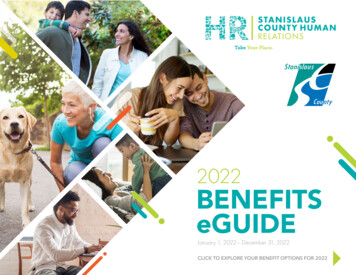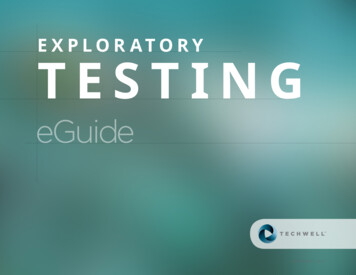
Transcription
Your eGuide to getting the most from yourNew York Life401(k) Savings PlanMore options for savings.For Agents1GETTING STARTEDUSING THE PLANTHINGS TO THINK ABOUTWHAT WOULD YOU DO?DEFINITIONSTABLE OF CONTENTS
Put the 401(k) Savings Planto work for your futureNo matter what your financial goals, the 401(k) Savings Plan can playan important role in helping you achieve them. It’s up to you to setthe wheels in motion and stay on course.New York Life is here to help. We provide the tools to help you planand save for a more secure financial future.Review this eGuide to see how the features of the 401(k) SavingsPlan can help you get the most value from your financial strategy.Learn about the Roth 401(k) optionThe plan offers a tax-advantaged Roth contribution featureas yet another tool to help you save for your retirement. You’llneed to decide if it’s right for you. Learn more now.2GETTING STARTEDUSING THE PLANTHINGS TO THINK ABOUTWHAT WOULD YOU DO?DEFINITIONSTABLE OF CONTENTS
In this eGuideGetting startedAbout this eGuideWhat’s your reason for saving?45Using the planThe 401(k) Savings Plan: A quick refresherHow pre-tax contributions workHow Roth contributions workMake up time with catch-up contributionsCompare your contribution options611131618Things to think aboutConsidering Roth?Think outside the plan1922What would you do?How others make the most of their retirementand savings plans:AllisonRobertEmilyKenneth24Elliott3GETTING STARTEDUSING THE PLANTHINGS TO THINK ABOUTWHAT WOULD YOU DO?DEFINITIONSTABLE OF CONTENTS
About this eGuideIt’s easy to find what you need in this interactive “eGuide.” You can read itfront to back or use the blue links to jump directly to the information youwant. Additionally, frequently used terms throughout are found on the“Definitions” tab below. This eGuide is fast and easy to use online, but youcan print it if you’d like.4GETTING STARTEDUSING THE PLANTHINGS TO THINK ABOUTWHAT WOULD YOU DO?DEFINITIONSTABLE OF CONTENTS
What’s your reason for saving?The reasons for saving are as unique as you are. Whether it’s buyinga new home, improving the one you have, paying for college, orsecuring your retirement—whatever your goal, there are manyways to make it happen.“My interest lies in the future, because I am going tospend the rest of my life there.”– Charles F. Kettering, American InventorIt is up to you to make it happen.If you have a short-term savings goal—a down payment on a house,for example—your savings strategy will be different than if you’replanning for retirement.Unfortunately, short-term goals can often crowd out a long-termobjective like saving for the future, especially if retirement is manyyears away. Even though retirement income is the most importantlong-term goal for most people, some wait until they’re close toretirement to consider their post-employment finances—andwind up disappointed in the results.New York Life provides the Nylic Retirement Plan to eligible Agents—it requires no contribution from you. And Social Security benefits willhelp. But to make sure that you can retire when you want with thelifestyle you want, a long-term savings and investment strategy isrequired. That’s where the 401(k) Savings Plan can help.The 401(k) Savings Plan is all about the long term.New York Life provides the 401(k) Savings Plan to help you savefor your future. You can take a loan or withdraw money from youraccount under certain circumstances, but the 401(k) is specificallydesigned for one thing—to help you retire with enough money toenjoy everything you’ve worked so hard to achieve. Of course, it’salways a good idea to have outside savings and investments as well,especially for short-term goals, emergencies, and other needs. Butthe tax and savings advantages of the 401(k) Savings Plan make ituniquely suited to help you save for retirement.NEXT: A quick overview of how the 401(k) Savings Plan works Think about this:Depending on when you retire, you may need income for 30or more years after you stop working. That can add up to a lotof money.5GETTING STARTEDUSING THE PLANTHINGS TO THINK ABOUTWHAT WOULD YOU DO?DEFINITIONSTABLE OF CONTENTS
The 401(k) Savings Plan:A quick refresherThe 401(k) Savings Plan is a convenient way for you to invest, build,and manage long-term financial resources for retirement. It’sconvenient because: Your contributions are automatically deducted from your Ledger,deposited into your account, and invested according to yourinstructions. You can choose how much hands-on control you want over yourinvestments, based on your comfort level. You can change your contribution rate and move your savings todifferent investment funds at any time. You’ll have access to a variety of tools that will help you gaugeyour progress toward your financial goals and make adjustmentsas needed.6GETTING STARTEDUSING THE PLANTHINGS TO THINK ABOUTWHAT WOULD YOU DO?DEFINITIONSTABLE OF CONTENTS
ContributionsYou can contribute from 1% to 15% (in whole percentage amounts)of your eligible commissions, subject to IRS limits. The InternalRevenue Code limits the maximum amount of eligible commissionsthat can be used to calculate contributions—for 2017 that limitis 270,000.If you’re considered highly compensated (for 2017, your 2016earnings exceeded a set amount), the maximum amount you cancontribute to the plan is different.You have a choice of making four different types of contributions:pre-tax, Roth, pre-tax catch-up, and Roth catch-up. P re-tax and pre-tax catch-up contributions are deducted fromyour Ledger before income tax is calculated, which lowers yourtaxable income for the current year. R oth and Roth catch-up contributions are deducted from yourLedger after taxes, so they don’t lower your current taxableincome.IRS and plan contribution limits (2017)401(k)Pre-tax 18,000 (combined with Roth)Roth 18,000 (combined with pre-tax)Catch-up 6,000 (in addition to other limits; only permitted if you areage 50 or older during the year; combined pre-tax and Roth)Combined15% of eligible commissions401(k)Note: For highly compensated participants, this limitand Rothis differentcontributionlimitSee how the contribution types compare.7GETTING STARTEDUSING THE PLANTHINGS TO THINK ABOUTWHAT WOULD YOU DO?DEFINITIONSTABLE OF CONTENTS
Company contributions.If you are under an active contract on December 31 of the previousyear, the company may make a contribution on your behalf to youraccount annually in March—even if you don’t contribute. Thiscontribution is made at the discretion of the Board of Directors, andgenerally represents a percentage of net renewal commissions,net renewal premiums, and cash values for the plan year for certainpolicies for which you are the original writing agent. If you do nothave an investment election in place, your company contribution willbe invested in the Fixed Dollar investment option until you make aninvestment election.All contributions (yours and the company’s) are always100% vested.8GETTING STARTEDUSING THE PLANTHINGS TO THINK ABOUTWHAT WOULD YOU DO?DEFINITIONSTABLE OF CONTENTS
Investment optionsThe 401(k) Savings Plan offers a number of different options you canchoose from: T arget Date Funds: Fund portfolios designed for your plannedretirement date. Core Funds: A variety of balanced, bond, and equity funds. F ixed Dollar Option: Provides a fixed or stated return, meaningthat the return is set for a period of time.You can find a complete list of the plan’s investment options andlearn more about these options on Your Benefits Resources (YBR)at http://resources.hewitt.com/newyorklife under “Savings andRetirement” and “Fund Prospectuses.” You can also request a copyof any of the prospectuses for the plan’s investment options bycalling the New York Life InfoLine at 1-888-513-4636.All the investment options are available for each type of contribution,including any company contributions. The plan’s investmentoptions offer a range of asset classes that allow you to diversifyyour investments based on your savings goals, risk tolerance, andhow long you have until retirement. You can mix and match yourinvestment options however you like to fit your needs.Or, consider using the online or professional management resourcesavailable to you through Aon Hewitt Financial Advisors, LLC (AFA).To connect with AFA: G o online: From Your Benefits Resources (YBR), select“Investment Advice” from the “Savings and Retirement” tab; S peak with an advisor: Call 1-888-513-4636, select “401(k)Savings and Deferred Plans,” and then select the “InvestmentAdvice” option. Advisors are available between 9 a.m. and 9 p.m.Eastern Time, Monday through Friday.Important Note:New York Life is not using New York Life Agents who areinvestment advisory representatives of Eagle Strategies, a NewYork Life company, for this process because ERISA imposessignificant restrictions on investment advice arrangementsbetween investment advisers (like New York Life’s EagleStrategies) and related retirement plans (like New York Life’sown 401(k) Savings Plans). Thus, we cannot use any New YorkLife Agent to advise participants in New York Life’s own 401(k)Savings Plans on their 401(k) account balances. The adviceservices being offered through Aon Hewitt are not subject tothese restrictions. In addition, as noted above, the advice beingoffered through Aon Hewitt is strictly limited to 401(k) accountbalances. We want to ensure that all New York Life Agents andEmployees are able to make informed decisions about their401(k) retirement savings and want to provide the resources todo so, should they need help.The 401(k) Savings Plan (“Plan”) has hired Aon Hewitt Financial Advisors, LLC (AFA) to provideinvestment advisory services to plan participants. AFA has hired Financial Engines Advisors, L.L.C.(FEA) to provide sub-advisory services. AFA is a federally registered investment advisor and whollyowned subsidiary of Hewitt Associates LLC. FEA is a federally registered investment advisor andwholly owned subsidiary of Financial Engines, Inc. New York Life, the Plan, AFA and FEA do notguarantee future results. Financial Engines is a registered trademark of Financial Engines, Inc. Allother marks are the exclusive property of their respective owners. 2005-2017 Financial Engines, Inc. All rights reserved. Used with permission.9GETTING STARTEDUSING THE PLANTHINGS TO THINK ABOUTWHAT WOULD YOU DO?DEFINITIONSTABLE OF CONTENTS
Getting your money out of the planManage your account onlineTax-advantaged plans like the 401(k) Savings Plan are specificallydesigned to help you save for retirement. Generally, the IRS requiresthat if you take a distribution from your 401(k) account before youreach age 59½, you will pay a 10% penalty in addition to any taxesyou may owe. While you’re an active New York Life Agent, youcan take and repay a loan from your 401(k) Savings Plan accountwithout owing taxes or paying a penalty. You can also take a hardshipwithdrawal under certain circumstances, but you may have to paytaxes and/or penalties, and your contributions may be suspendedfor six months.To enroll, change, stop, or restart your contributions, or to changeyour investment options, visit Your Benefits Resources (YBR). Whileyou’re there, you can learn more about the investment optionsunder “Savings and Retirement” and “Fund Prospectuses.”You can also manage your account and request investment fundinformation by calling the New York Life InfoLine at 1-888-513-4636and speaking with a Benefits Center representative.For more details about how the 401(k) Savings Plan works, visitwww.nylbenefits.com under “Savings and Retirement” and referto the Summary Plan Description for the Agents Progress-SharingInvestment Plan, which is available on the Agency Portal or on YourBenefits Resources (YBR).NEXT: Learn about pre-tax contributions 10GETTING STARTEDUSING THE PLANTHINGS TO THINK ABOUTWHAT WOULD YOU DO?DEFINITIONSTABLE OF CONTENTS
How pre-taxcontributions workWhen you make pre-tax contributions (including catch-upcontributions) to the 401(k) Savings Plan, the money is deductedfrom your Ledger before income taxes are calculated and withheld.As a result, your taxes are calculated on a lower amount, so you don’tpay as much in income tax as you would otherwise.How much you can contributeEach year, the IRS sets a limit on the amount of pre-tax contributionsyou can make to the 401(k) Savings Plan. This annual maximumpre-tax contribution limit is 18,000 in 2017. (If you make Rothcontributions, those are also included in this annual pre-tax limitbecause earnings on Roth contributions are tax-free.*) Catch-upcontributions are allowed in addition to this limit.* To receive a tax-free distribution of earnings, you must be at least age 59½ (or disabled) and the Rothaccount must be at least five years old.11GETTING STARTEDUSING THE PLANTHINGS TO THINK ABOUTWHAT WOULD YOU DO?DEFINITIONSTABLE OF CONTENTS
When you pay taxesYour pre-tax contributions and their investment earnings arenot taxed until you take a distribution. Distributions of pre-taxcontributions and their earnings are taxed like regular income. If youtake a distribution before you reach age 59½, generally you’ll pay a10% penalty in addition to the tax you owe.Advantages of pre-taxcontributionsDisadvantages of pre-taxcontributionsWho might benefit from pre-taxcontributionsMost Agents will benefit from making at least some pre-taxcontributions to the 401(k) Savings Plan. You should consider thesecontributions if you: Like the idea of paying less in taxes now, in exchange for payingthem when you take the money out. Think you’ll be in a lower tax bracket when you take the money fromyour account than you’re in now. Can delay taking a distribution to avoid early withdrawal penalties. Your current taxable income is There is a limit to the amount ofreduced by the amount of yourcontributions you can make. Thecontributions, meaning you owe lessmaximum annual contribution amountin current taxes.is 18,000 in 2017, including Rothcontributions. Account can grow faster becauseyou don’t pay taxes on contributionsand earnings until distribution. You could owe more than plannedbecause distributions increase yourtaxable income and could place you ina higher tax bracket.NEXT: Learn about Roth contributions 12GETTING STARTEDUSING THE PLANTHINGS TO THINK ABOUTWHAT WOULD YOU DO?DEFINITIONSTABLE OF CONTENTS
How Rothcontributions workRoth contributions are deducted from your Ledger after income taxes arecalculated and withheld, and they don’t lower your current taxable income.You also don’t pay taxes on Roth contributions or earnings* at the time ofdistribution.* You must be at least age 59½ (or disabled) and the Roth account must be at least five years old at distribution.How much you can contributeRoth contributions fall under the same IRS limit as pre-tax contributions. In2017, this annual limit is 18,000. The combined total of your Roth contributionsplus pre-tax contributions can’t exceed this limit. Catch-up contributions areallowed in addition to the limit.“Exceeding the limit” with Roth contributions.Making Roth contributions may allow you to effectively “exceed” the IRScontribution limit, depending on market performance, your current taxbracket compared to your tax bracket at retirement, and how long your Rothcontributions are left in the account to earn tax-free interest. For instance, ifyou were to max out the limit in Roth contributions (and tax rates in retirementare the same or higher than they are now) you could have a larger balanceat retirement, after payment of taxes, than you would making the samecontribution in pre-tax dollars.Think about this:You can convert your existing pre-tax account balances to a Rothaccount, but there are important considerations. Learn more.13GETTING STARTEDUSING THE PLANTHINGS TO THINK ABOUTWHAT WOULD YOU DO?DEFINITIONSTABLE OF CONTENTS
When you pay taxesThe key advantage of Roth contributions is that you also may notbe required to pay taxes on the earnings in your account—whichmeans tax-free income in retirement.To avoid a penalty, the earnings on Roth 401(k) contributions can onlybe withdrawn after age 59½ (or if you become disabled). The Rothaccount must also be at least five years old at distribution, or theearnings will be taxable.Think about this:If your Roth (plus pre-tax) contributions put you over theannual pre-tax limit ( 18,000 for 2017), your Roth (and pre‑tax)contributions stop for the rest of the year.Advantages of RothcontributionsDisadvantages of Rothcontributions You won’t owe taxes on thecontributions in your account whenyou withdraw them.* You pay more in current taxes. Your account can grow fasterbecause you don’t pay taxes onearnings. You’ll pay a penalty if you take moneyfrom your Roth account before age59½ or if the account is less than fiveyears old. You can only contribute up to the 2017 Qualified distributions don’t increase annual 18,000 pre-tax limit (Roth plusyour taxable income.pre-tax contributions).* You must be at least age 59½ (or disabled) and the Roth account must be at least five years oldat distribution.14GETTING STARTEDUSING THE PLANTHINGS TO THINK ABOUTWHAT WOULD YOU DO?DEFINITIONSTABLE OF CONTENTS
Who might benefit from Roth contributionsYou should consider making Roth contributions if you: Think you’ll be in the same or higher tax bracket at retirement thanyou’re in now.IMPORTANT: Roth contributions are irrevocable. You can alwaysstop making Roth contributions at any time, but you cannotconvert existing Roth account balances into pre-tax savings. Have a longer time until retirement to allow more compounding oftax-free earnings. Would rather pay the taxes on your contributions now in exchangefor tax-free retirement income.NEXT: Learn about catch-up contributions 15GETTING STARTEDUSING THE PLANTHINGS TO THINK ABOUTWHAT WOULD YOU DO?DEFINITIONSTABLE OF CONTENTS
Make up time withcatch-up contributionsCatch-up contributions allow Agents—especially those who mayhave begun saving later in life—to save an additional amount in the401(k) Savings Plan as they get closer to retirement.How they workIf you will be age 50 or older at any time during the year, you canmake catch-up contributions, which allow you to exceed the normalannual maximum contribution limits. You can make pre-tax or Rothcatch-up contributions, or any combination.How much you can contributeEach year, the IRS sets a limit on the amount of catch-upcontributions you can make to the 401(k) Savings Plan. In 2017,you can make an additional 6,000 in catch-up contributions.16GETTING STARTEDUSING THE PLANTHINGS TO THINK ABOUTWHAT WOULD YOU DO?DEFINITIONSTABLE OF CONTENTS
Who might benefit from catch-upcontributionsMost Agents who are eligible will benefit from making catch-upcontributions—saving too much for retirement is a pretty rareproblem. You should especially consider catch-up contributions if you:When you pay taxesCatch-up contributions are taxed based on the type of contributionyou make: pre-tax or Roth. Didn’t start saving for retirement until later in life. Have depleted other savings. Would like to have additional retirement savings for health careexpenses or the unexpected.NEXT: Compare your 401(k) contribution options 17GETTING STARTEDUSING THE PLANTHINGS TO THINK ABOUTWHAT WOULD YOU DO?DEFINITIONSTABLE OF CONTENTS
Compare your contribution optionsHow you use the 401(k) Savings Plan to save for retirement is a personal decision. Just like there are many different reasons to save,there’s no “right” or “wrong” type of contribution. Each has its own strengths. In fact, some financial experts recommend a combination ofcontribution types, as a sort of “tax diversification” strategy. You can even convert existing pre-tax savings into Roth savings. Learn how.New York Life offers these different kinds of contributions precisely because each individual has unique retirement goals, needs, and savingspreferences. Here’s a quick side-by-side comparison of the different contribution types.Pre-taxRothCatch-up 18,000 (combined with Roth)1 18,000 (combined with pre-tax)1 6,000 (combined pre-tax and Roth)Contributions from LedgerNot taxed (until distribution)Taxed in the year earnedEarningsTaxed at distributionNot taxedTaxed based on the type ofcontributionsAt distributionPay taxes on contributionsand earningsNo taxes due2Penalty for distributions beforeage 59½Yes, on contributions and earningsYes, penalty on earnings only(unless disabled)2017 annual maximumcontributionTax treatmentPenalty based on the type ofcontributions he plan’s combined pre-tax and Roth contribution limit is 15% of your eligible commissions. If you’re considered highly compensated (for 2017, your 2016 earnings exceeded a set amount), theTmaximum amount you can contribute to the plan is different.1To receive a tax-free distribution of earnings, you must be at least age 59½ (or disabled) and the Roth account must be at least five years old at distribution.2IMPORTANT: Roth contributions are irrevocable. You can always stop making Roth contributions at any time, but you cannotconvert existing Roth account balances into pre-tax savings.NEXT: If you’re thinking about adding Roth to your savings 18GETTING STARTEDUSING THE PLANTHINGS TO THINK ABOUTWHAT WOULD YOU DO?DEFINITIONSTABLE OF CONTENTS
Considering Roth?Roth contributions provide another way to prepare financially for your future with the401(k) Savings Plan. But Roth contributions may not be for everyone, and there are issuesyou should think about carefully before adding Roth contributions to your savings strategy.Learn how Roth contributions work.TaxesRoth contributions are made after taxes are deductedfrom your Ledger. Which means, unlike just a pre-taxaccount, a Roth 401(k) account can provide tax-freeincome in retirement.*Think about this:You should discuss theadvantages and disadvantagesof Roth 401(k) contributionswith your tax or financial advisor.That’s certainly an attractive feature, but it requiresyou to think about your situation, and especially yourtax bracket—both now and when you plan to retire. Of course, future tax rates are nevereasy to predict. But consider that when you take your money out of your 401(k) SavingsPlan in retirement: If you think you’ll be in a lower tax bracket than you’re in now, pre-tax contributions maymake more sense than Roth, because pre-tax contributions save you money on taxestoday. Even though you’ll be paying taxes on pre-tax contributions and earnings in thefuture, it could be less than you’d pay today. If you think you’ll be in the same or higher tax bracket than you are now, Roth contributionsmight be a good option because your tax liability would be greater in the future, and you’davoid paying taxes on the earnings in your account.* To avoid taxes and penalties at distribution, your Roth 401(k) account can only be withdrawn after age 59½ (or if youbecome disabled) and the Roth account must be at least five years old.GETTING STARTEDUSING THE PLANTHINGS TO THINK ABOUTWHAT WOULD YOU DO?DEFINITIONS19TABLE OF CONTENTS
TimeIf you convert 500,000: If you convert 40,000:How long until you think you’ll retire? Because the more time youhave until you need the money in your account, the more likely you’llbenefit from Roth 401(k) contributions.Tax bracket40%22%Assumptions33% federal tax, 7% state tax15% federal tax, 7% state taxHere’s why. Earnings can grow substantially through compounding—the longer you can let them compound, the more potential forgrowth. And since earnings aren’t taxable in a Roth account,*you could avoid a potentially large tax bill at distribution witha Roth account compared to a pre-tax account.Tax payablefor year ofconversion 200,000 8,800* To avoid taxes and penalties at distribution, Roth 401(k) earnings can only be withdrawn after age 59½(or if you become disabled) and the Roth account must be at least five years old.Converting your current eligible balancesYou can convert all or a portion of your current eligible 401(k)Savings Plan account balance to a Roth account (called an in-planconversion). However, be sure you understand the tax implications(including state and local taxes, if applicable) before you request sucha conversion.There are important tax considerations with a Roth in-planconversion. When you convert existing pre-tax money into a Rothaccount, those dollars instantly become taxable income in the yearthe conversion is complete. Which means you could face a sizabletax bill (and the conversion could bump you into a higher tax bracketfor that year).GETTING STARTEDUSING THE PLANThe increase in taxable income from the conversion could put you overan income threshold that could impose additional tax on investmentincome.You may also need to increase your tax withholding amount for theyear of the conversion or make estimated tax payments to avoid anunderpayment penalty.What happens if I withdraw money from my Rothaccount within five years of the conversion?You’ll owe taxes on the earnings in the account. If you’re under age59½, you’ll owe an additional 10% penalty on the entire earningsamount that you withdraw (unless an exception applies).THINGS TO THINK ABOUT20WHAT WOULD YOU DO?DEFINITIONSTABLE OF CONTENTS
Is an in-plan Roth conversion rightfor you?Be sure to consult a financial or tax advisor to explore the taximplications before requesting a Roth conversion. Here are someconsiderations to get you started:You might benefit from anin-plan conversion if you:You might not benefit from anin-plan conversion if you: Expect your tax rate to be the sameor higher in the future. Expect your tax rate to be lower inretirement than it would be at the timeof conversion. Are interested in tax diversification(owning assets taxed at differentrates to cushion against changes intax rates or taxable income). Plan to keep the money invested forat least five years before taking awithdrawal.How to request an in-plan conversionIf you decide that an in-plan conversion is right for you, you caninitiate a conversion (up to two requests per year) on Your BenefitsResources (YBR). After you log on, select Convert to Roth 401(k)under the Savings and Retirement tab and follow the steps.Get some helpUse the tools available to you on Your Benefits Resources (YBR)at http://resources.hewitt.com/newyorklife to help you decidewhether Roth contributions might be right for you.If you have questions, call the New York Life InfoLine at1-888-513-4636 to speak with a Benefits Center representative. Will need to access your money withinfive years of the conversion. Would find it difficult to pay the taxowed on the amount of the conversion.NEXT: Thinking outside the plan 21GETTING STARTEDUSING THE PLANTHINGS TO THINK ABOUTWHAT WOULD YOU DO?DEFINITIONSTABLE OF CONTENTS
Think outside the planNew York Life’s Nylic Retirement Plan and 401(k) Savings Plan forma solid foundation for building your retirement finances. But as anyfinancial advisor will tell you, diversification is a key to successfulsaving and investing.Some liquidity is importantYou generally don’t receive your Nylic Retirement Plan benefits untilyou retire. Your 401(k) Savings Plan money is more accessible, but italso has restrictions (because it’s intended for long-term savings). You can take a loan from your 401(k), but the money you take out stopsearning investment returns and compounding until you repay it. Hardship withdrawals are available, but only under certaincircumstances. Not only do you lose any earnings on thatmoney, but you could also have tax and/or penalty costs.The ability to get to your money when you need it—liquidity—is oneof the reasons it’s important to have savings outside your New YorkLife plans. In addition to fully liquid bank accounts, stocks, and mutualfunds, there are also some tax-favored savings options, such as IRAsand tuition savings plans that you may be able to take advantage of,depending on your annual earnings and other factors.Think about this:Talk to your financial advisor about how to create an overallsavings strategy that combines New York Life’s retirementand savings plan with outside financial opportunities.22GETTING STARTEDUSING THE PLANTHINGS TO THINK ABOUTWHAT WOULD YOU DO?DEFINITIONSTABLE OF CONTENTS
Watch how much you contribute tothe 401(k) Savings PlanThere is such a thing as contributing too much in pre-tax and/orRoth contributions. The 401(k) Savings Plan has a contribution limitimposed by the IRS, and that limit includes Roth contributions. In2017, the maximum annual limit is 18,000. Once the total of yourpre-tax and Roth contributions hit that limit, they stop until thefollowing year.Think about this:Catch-up contributions aren’t included in the pre-taxcontribution limit.NEXT: See how others make the most of theirretirement and savings plans 23GETTING STARTEDUSING THE PLANTHINGS TO THINK ABOUTWHAT WOULD YOU DO?DEFINITIONSTABLE OF CONTENTS
What would you do?Your New York Life 401(k) Savings Plan is a powerful tool that canhelp you secure your future. But everyone’s situation is unique—your goals, age, earnings, priorities, savings habits, etc.—so gettingthe most from your plan requires some thought and planning, andperhaps some advice from tax or financial experts.It can also help to see how others structure their savings strategiesbased on their specific situation.Meet Allison, Robert, Elliott, Emily,and KennethThese aren’t real New York Life Agents, but one or more of their“stories” may sound familiar to you. In the next few pages, you’llmeet each of them, learn about their financial and retirement goals,and how they use the 401(k) Savings Plan to help achieve them.Obviously, none of their situations will match yours exactly, butperhaps you can apply some of their thought processes to your own.IMPORTANTThe following scenarios are representative examples only and arenot based
401(k) retirement savings and want to provide the resources to do so, should they need help. The 401(k) Savings Plan ("Plan") has hired Aon Hewitt Financial Advisors, LLC (AFA) to provide investment advisory services to plan participants. AFA has hired Financial Engines Advisors, L.L.C. (FEA) to provide sub-advisory services.










